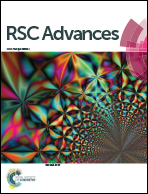Doping effect and oxygen defects boost room temperature ferromagnetism of Co-doped ZnO nanoparticles: experimental and theoretical studies†
Abstract
Co-doped ZnO nanoparticles with different dosage concentrations were fabricated by a thermal decomposition method. The nanoparticles show a pure wurtzite structure without the formation of a secondary phase or Co clusters, in which Co ions present as Co2+ and occupy Zn2+ tetrahedral sites within the ZnO matrix. All the samples show ferromagnetic properties at room temperature with nonzero coercivity and remanence magnetization. Besides, the magnetic data is also fitted by the model of bound magnetic polarons (BMP). By increasing the Co2+ doping concentration, the saturation magnetization values of Co-doped ZnO nanoparticles increase first and then decreases, which is related to the variation tendency of oxygen defects  on the surface and the number of BMPs. This phenomenon can be ascribed to the formation of defect-induced BMPs, in which
on the surface and the number of BMPs. This phenomenon can be ascribed to the formation of defect-induced BMPs, in which  ferromagnetic coupling occurs at lower Co2+ concentration and Co2+–O2−–Co2+ antiferromagnetic coupling arises at higher Co2+ concentration. Air annealing experiments further demonstrate this result, in which the saturation magnetization of Co-doped ZnO nanoparticles is reduced after annealing in Air. The doping effect and oxygen defects on the magnetic ordering of Co-doped ZnO were calculated using density functional theory. The calculation results reveal that stable long-range magnetic ordering in Co-doped ZnO nanoparticles is mainly attributed to the localized spin moments from 3d electrons of Co2+ ions. Both the experimental and theoretical studies demonstrate that the ferromagnetism in Co-doped ZnO nanoparticles is originated from the combined effects of Co doping and oxygen vacancies. These results provide an experimental and theoretical view to understand the magnetic origination and tune the magnetic properties of diluted magnetic semiconductors, which is of great significance for spintronics.
ferromagnetic coupling occurs at lower Co2+ concentration and Co2+–O2−–Co2+ antiferromagnetic coupling arises at higher Co2+ concentration. Air annealing experiments further demonstrate this result, in which the saturation magnetization of Co-doped ZnO nanoparticles is reduced after annealing in Air. The doping effect and oxygen defects on the magnetic ordering of Co-doped ZnO were calculated using density functional theory. The calculation results reveal that stable long-range magnetic ordering in Co-doped ZnO nanoparticles is mainly attributed to the localized spin moments from 3d electrons of Co2+ ions. Both the experimental and theoretical studies demonstrate that the ferromagnetism in Co-doped ZnO nanoparticles is originated from the combined effects of Co doping and oxygen vacancies. These results provide an experimental and theoretical view to understand the magnetic origination and tune the magnetic properties of diluted magnetic semiconductors, which is of great significance for spintronics.



 Please wait while we load your content...
Please wait while we load your content...